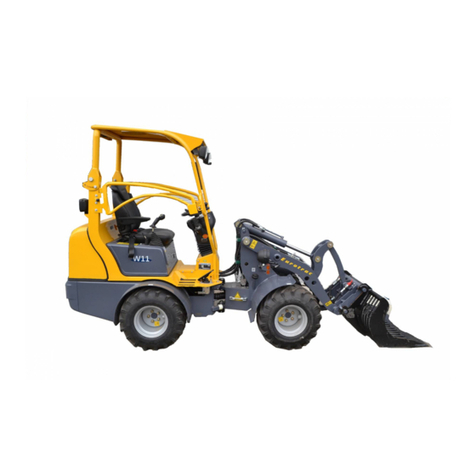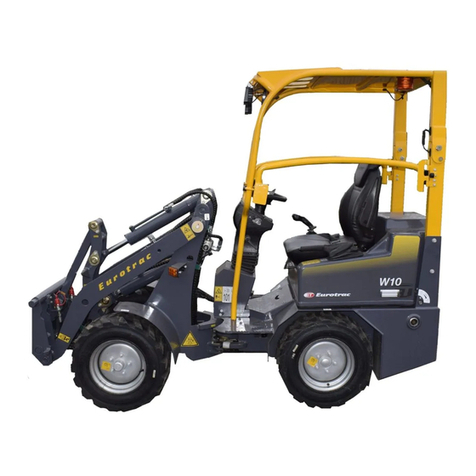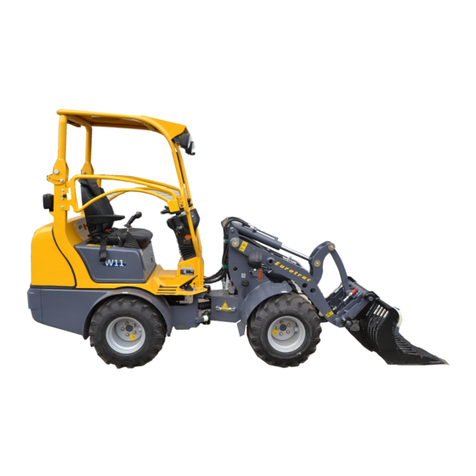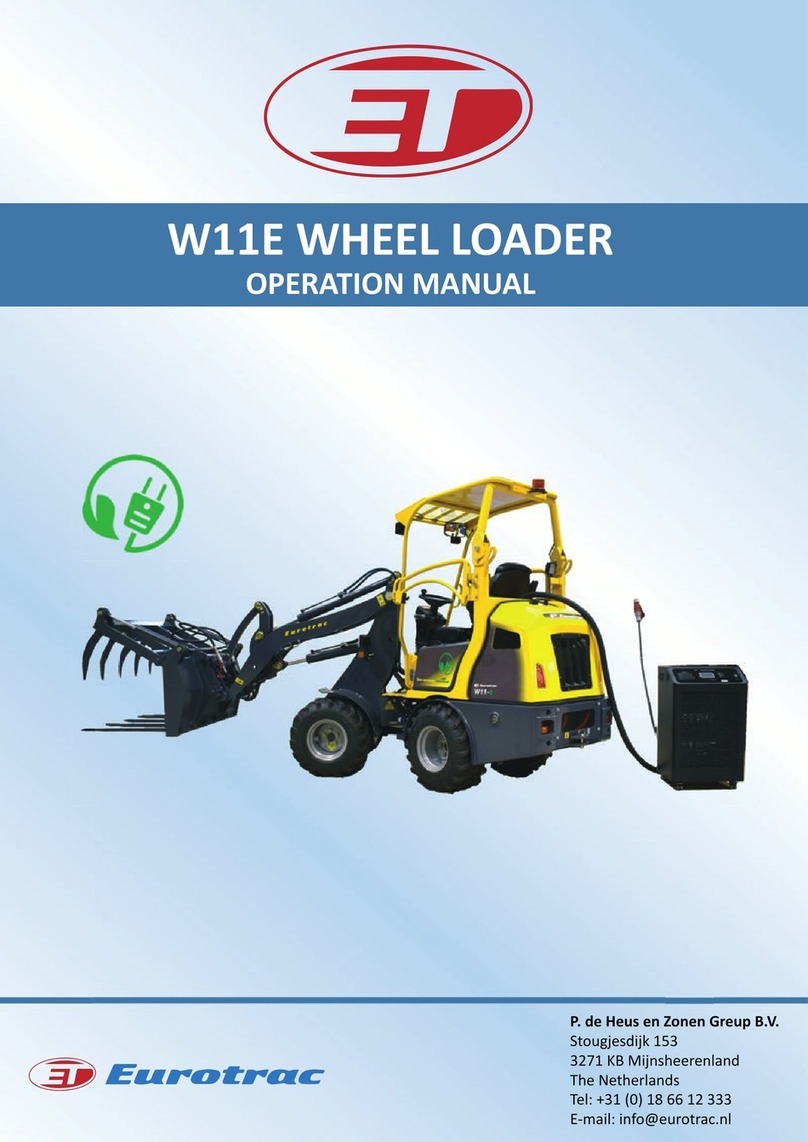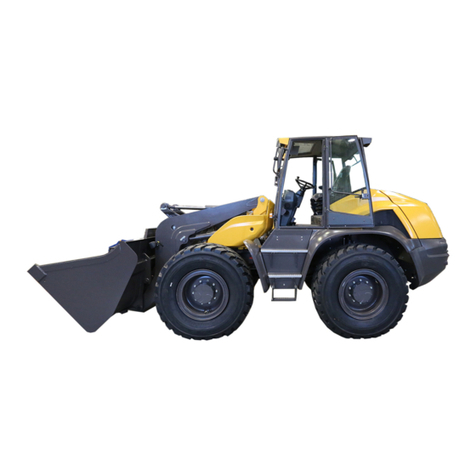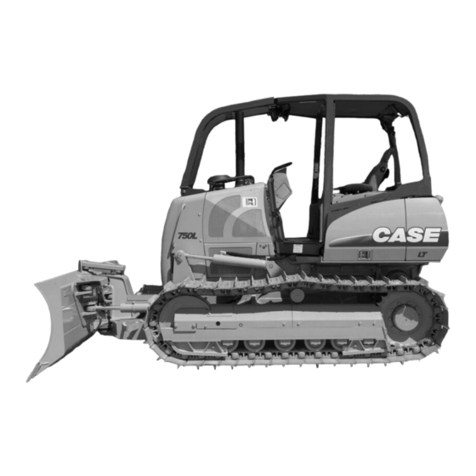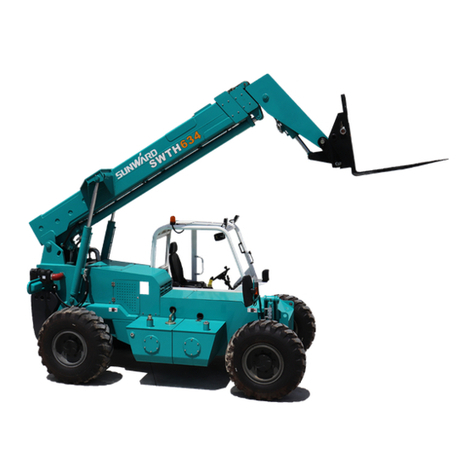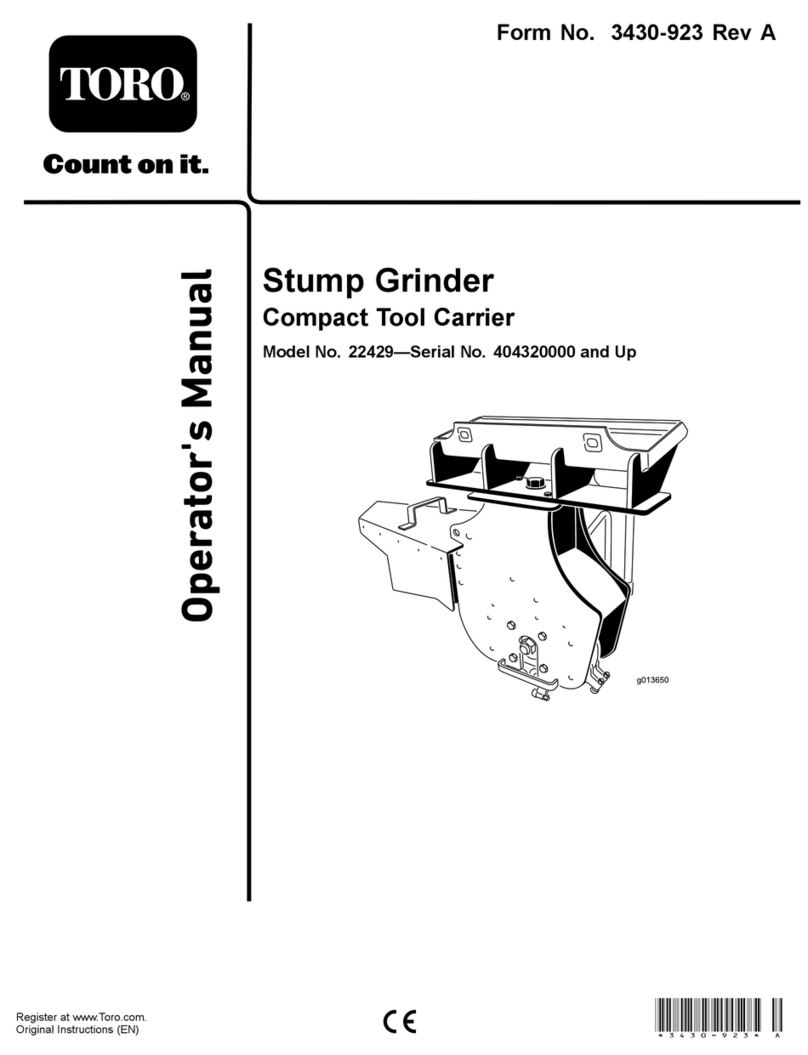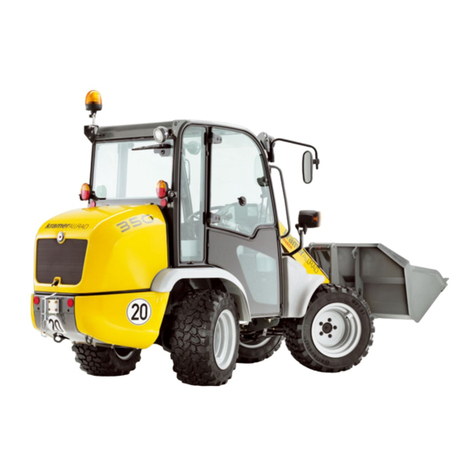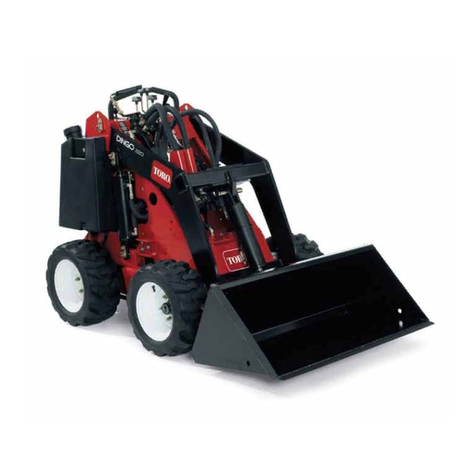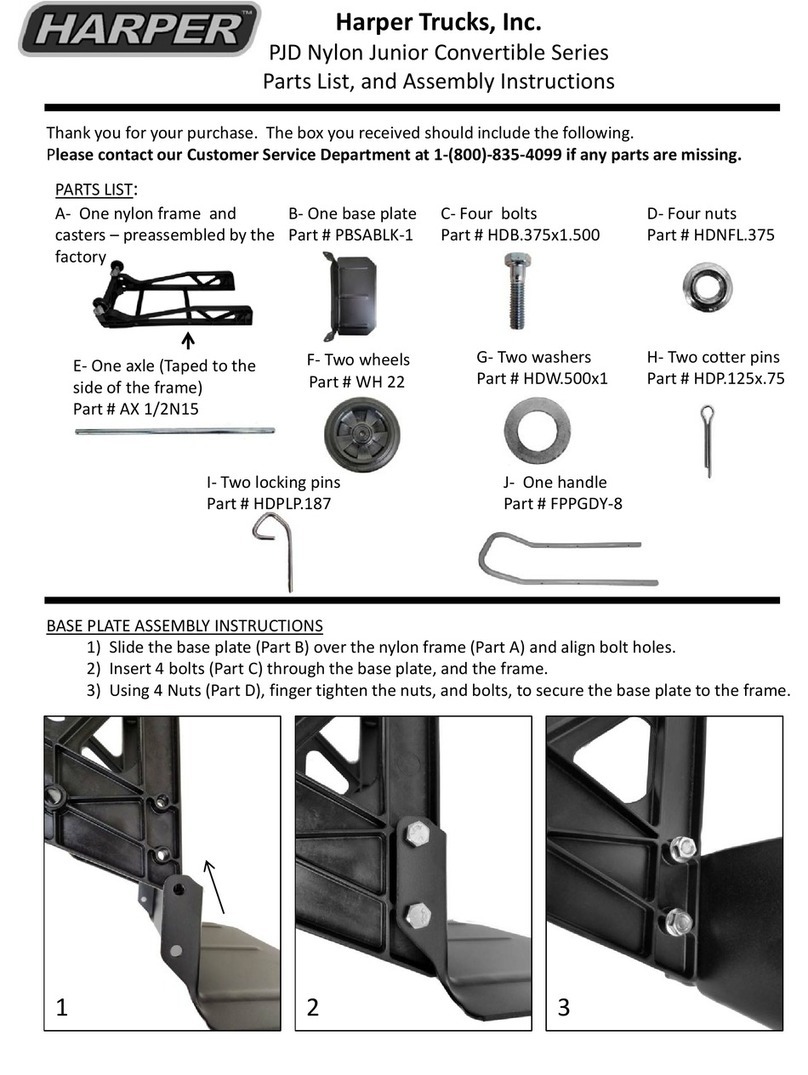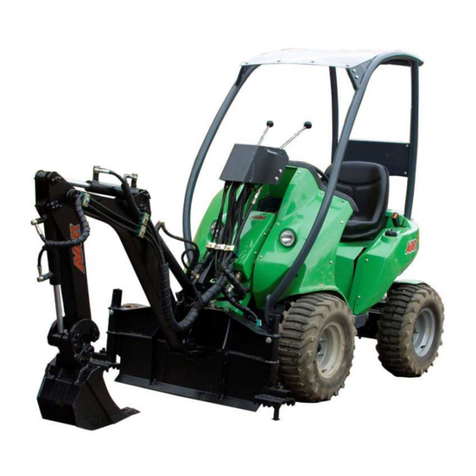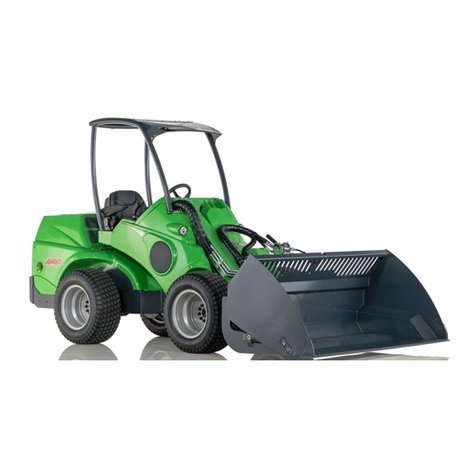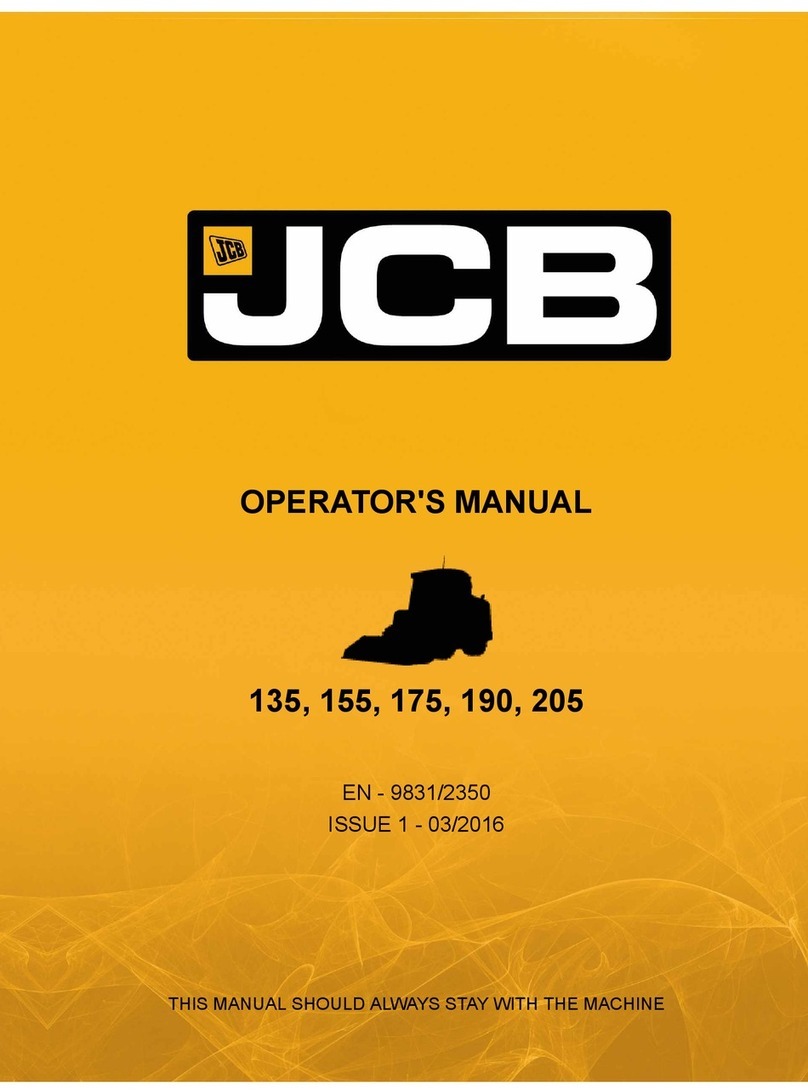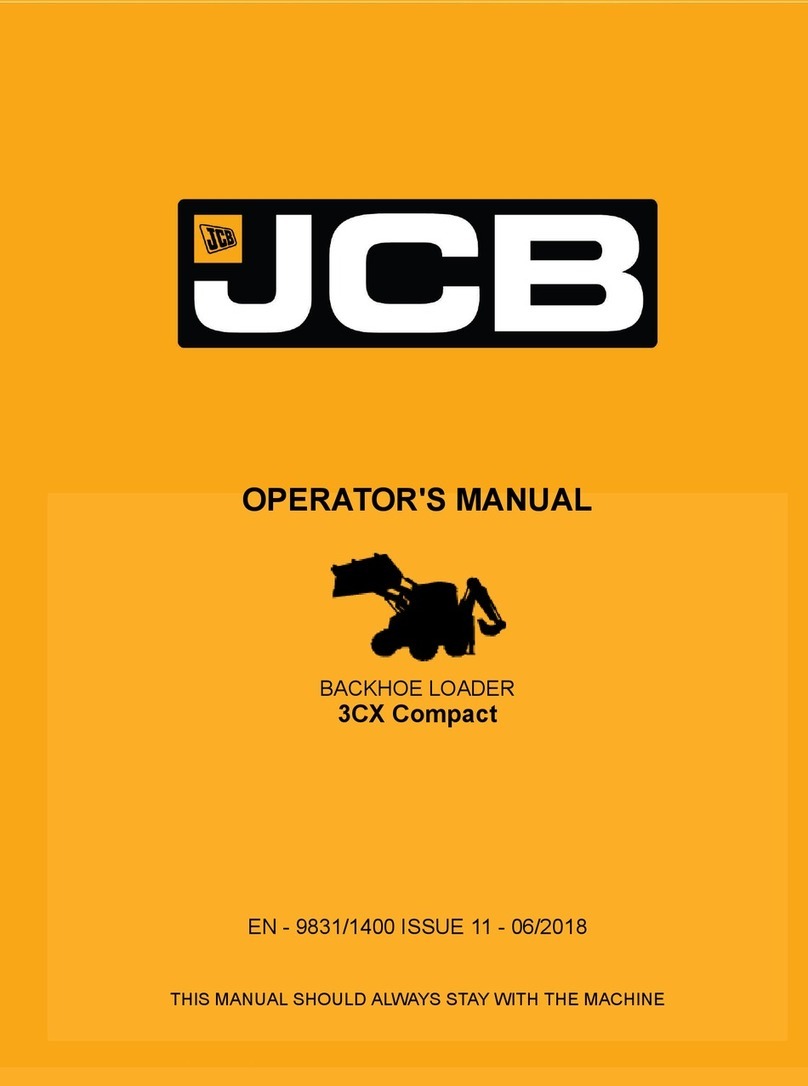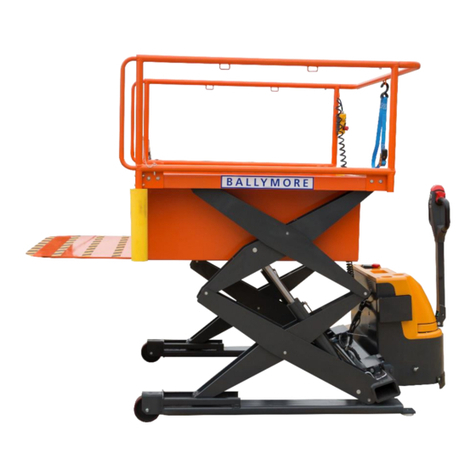Eurotrac W11 User manual

1
Operation Manual
W11/W12/W13/T13 Series
Wheel Loader

2
0BFOREWORD
W11,W12,W13,T13 Series loader is one of FIRST AVENUE self-developed new less
than 2ton multi-function mini-loaders, this loader is a ideal product for material loading and
unloading, short-distance transport, can be matched with many accessories, can be realized
more kinds of uses, such as lifting, pulling, clamp hold, digging drill, ground, weeding, feed-
ing fodder, etc. It can widely used in farm, ranch, infrastructure, road construction, stations,
boatyard and other work places, this machine has the characteristics of the best economy,
safety, and driving comfort. And these good characteristics depend on you, loaders and oth-
er operators to maintain, fully play during operating.
This manual covers all important knowledge of the starting use of the new loader, driving
and operation, care and maintenance for W11,W12,W13,T13series wheel loaders. Please
follow the instructions of the loaders, regular inspect and maintenance the working content
specified on the table, and use the provisions of the working media.
This manual can be used for W11,W12,W13,T13 model.
For some special technical skills and knowledge about maintenance and repair, be-
cause of needing to use special accessories, be not mentioned in this statement, please
contact the FIRST AVENUE dealer.
Loader maintenance andrepairworkisonlyallowed tobe done byqualified
professionals who are authorized by FIRST AVENUE.
In order to make your loader to obtain a valid warranty services, the maintenance must
be must be done on time by qualified professionals who is authorized by FIRST AVENUE.

3
CONTENT
SECTION 1: RECORD OF REVISIONS............................................................................
1
SECTION 2: GENERAL WARRANTY CONDITIONS..................................................
2
SECTION 3: GENERAL WARNING...............................................................................
5
SECTION 4: INFORMATION AND OPERATION…………………………………………….
8
A. MAIN CONFIGURATION.............................................................................
8
B. OPERATOR‘S RESPONSIBILITY..............................................................................
11
C. MACHINERY RESPONSIBILITY..............................................................................
10
CHAPTER 1.......................................................................................................................
13
GENERAL INFORMATION & OPERATING INSTRUCTIONS..........................................
13
SECTION 1: MAIN COMPONENTS..............................................................................
14
A. ENGINE AND PUMP.....................................................................................................
14
B. CYCLOID MOTOR AND DRIVE AXLE..........................................................................
14
C. BRAKE SYSTEM...........................................................................................................
14
D. WHEEL AND TYRE.......................................................................................................
14
E. OIL TANK.......................................................................................................................
15
F. ELECTRIC SYSTEM......................................................................................................
15
G. QUICK REMOVAL DEVICE..........................................................................................
15
H.SEAT.......................................................................................................................
15
I. ATTACHMENT................................................................................................................
17
J. MULTI-FUCTION CONTROL HANDLE........................................................................
18
K. PARKING BRAKE.........................................................................................................
23
L. ATTACHMENT...............................................................................................................
24
M. DISPLAY PANEL...........................................................................................................
28
SECTION 2: OPERATING PROCEDURE........................................................................
31
SECTION 3: SPECIFICATIONS AND PERFORMANCES........................................
41
SECTION 4: TRANSPORT PROCEDURE...............................................................
48

4
SECTION 5: TRAILER PROCEDURE...............................................................................
49
SECTION 6: STORAGE PROCEDURE.....................................................................
50
CHAPTER 2.......................................................................................................................
51
MAINTENANCE PARTS....................................................................................................
52
SECTION1: SERVICE................................................................................................
54
A. Preparation for Use........................................................................................
54
B. REGULAR MAINTENANCE TABLE..............................................................................
55
C. OIL&LUBRICATING OIL................................................................................................
67
SECTION2: CORRECTIVE MAINTENANCE..............................................................
68
A. ENEGY OF MOTION REDUCTION..............................................................................
68
B. DRIVE AXLE...........................................................................................................
69
C. BRAKE SYSTEM...................................................................................................
70
D. GENERATOR...............................................................................................................
71
ANNEX 1:HYDRAULIC DIAGRAM....................................................................................
72
ANNEX 2:ELECTRIC DIAGRAM........................................................................................
75
ANNEX 3:FRAME LABLE DIAGRAM.................................................................................
77
ANNEX 4:DAILY EQUIPMENT INSPECTION.................................................................
78

5
SECTION1:RECORD OF REVISIONS
Continuing improvement and advancement of product design may cause changes to the
model group which may not be included in this publication.
Each publication is reviewed and revised, as required, to update and include the
changes in later additions.
We reserves the right to modify or make changes within a specific model group without
notice and without incurring any liability to retrofit tractors previously shipped from the factory.
Contact your First Avenue Industry dealer for maintenance that is not covered in this
publication.
ISSUE DATE
UPDATE MUMBER
DISASSEMBLY
INSERTED
DESCRIPTION OF CHANGE

6
SECTION2:GENERAL WARRANTY CONDITIONS
This document presents the warranty conditions offered to any customer for all the
pieces of equipments manufactured in the First Avenue Industry facilities and sold to him
through the authorized Sales and Service network.
The general warranty conditions hereunder described do govern the relationship
between final customer of a First Avenue Industry product, hereunder called ―the buyer‖ and
First Avenue Industry factory, called ―the manufacturer―.
The fact that the buyer places an order of a First Avenue Industry product means that
he has read the present policy and does accept its provision. Any other general or particular
provision, that differs from or contradicts one of the general or particular conditions described
hereafter which may appear in any document from the buyer and especially in its general
purchasing conditions, cannot be used against the manufacturer unless accepted by First
Avenue Industry in a written agreement.
ARTICLE 1:
First Avenue Industry warrants that each new item of equipment is of good workmanship
and is free from mechanical defects provided that:
1) The product is installed and operated in accordance with printed First Avenue Industry
Equipment‘s instructions.
2) The product is used under normal operating conditions, for which it is designed,
3) The product is not subject to misuse, negligence or accident,
4) The product receives proper care, lubrication, protection and maintenance under the
supervision of trained personnel,
5) The product is normally protected from exterior aggressions whatever their origin.
ARTICLE 2:
This warranty expires, unless otherwise agreed by First Avenue Industry in a special
provision, 15 months after shipment by the manufacturer, or 12 months after being placed in
service, or after 1000 operating hours.

7
ARTICLE 3:
The First Avenue Industry Warranty is strictly limited to the replacement of defective
parts and if the repair does justify it, to the assistance of a technician. Parts shipping
expenses, traveling and housing expenses of personnel are to be paid by customer.
ARTICLE 4:
The First Avenue Industry Warranty does not apply to fluids, oils, fuses, bulbs,
accumulators, paint, seals, tires, bumpers, pads and other consumables or normally wearing
type items unless found to be defective prior to use.
ARTICLE 5:
All warranty claims from the Buyer must be sent by written to Seller who will be in
charge of dealing with the Manufacturer to address the problem in a timely manner.
ARTICLE 6:
All the expenses related to a warranty claim will be invoiced to the buyer until First
Avenue Industry employees have evaluated the claim. Whatever the circumstances, the
buyer should not refuse or delay the payment. If the evaluation concludes to First Avenue
Industry ‘ s full responsibility, a credit memo will be issued in favor of the buyer.
Under no circumstance other than those accepted by First Avenue Industry , the buyer
of the defective parts at the manufacturer address can accept without a formal letter from the
buyer and without the effective return no warranty claim.
ARTICLE 7:
This warranty is extended by First Avenue Industry only to the buyer of new products
from First Avenue Industry or of its authorized distributors. The products purchased under
this warranty are intended for use exclusively by the buyer and his employees and by no
other person. Therefore, there shall be no third party beneficiary of this warranty.

8
ARTICLE 8:
This warranty does only apply to the primeval reason. In other words, the
consequences on the product linked to its use after first problem are not covered by this
warranty.
ARTICLE 9:
Under no circumstances whatever shall First Avenue Industry and the seller be liable
for any special or consequential damages, whether based on lost goodwill, lost resale profits,
work stoppage, impairment of other goods or otherwise, and whether arising out of breach of
any express or implied warranty, breach of contract, negligence or otherwise, except only in
the case of personal injury as may be required by applicable law
ARTICLE 10:
The warranty is automatically void in the following cases:
1) The product has received some modification, not advised by First Avenue Industry
or not done following First Avenue Industry requirements
2) Some original parts have been replaced by parts not provided by First Avenue
Industry .
ARTICLE 11:
This warranty and all undertaking of First Avenue Industry shall be governed by the
laws of manufacturer‘s country and discussed in front of nearest court from the
manufacturer‘s facility even in case of multiple of defenders.

9
SECTION3 GENERAL WARNING
FOREWORD
This instruction manual is intended for all users of the machine: the company manager, the
Department Head, the driver, as well as the whole personnel who works with or near to the equipment
GENERAL WARNING:
1.Before using the machine, go through this manual and comply with all its instructions
2. Also carefully read the instructions that appear on the plates fixed onto the machine and keep
them readable
3. Keep this instruction manual at the disposal of all operators
4. Make sure that any person to whom you entrust the machine is qualified to fulfill the safety
requirements linked to its use
5. Avoid unsupervised interventions on your equipment when not being used
6. Never use a machine which does not looks to be in good condition
7. Never apply a load or a stress exceeding the maximum operating load of the machine
8. Never use the machine for an operation it is not designed to perform
9. Become thoroughly familiar with the safety regulations applicable to the machine and enforce
them scrupulously
10.The manufacturer declines his responsibility for the consequences of a disassembly of the
machine or any modification made without his supervision
OBLIGATION TO GO THROUGH THE USER’S MANUAL
The company manager is compelled to make the operators fully acquainted with the
regulations of the instruction manual.
Read this entire chapter BEFORE attempting to operate this loader
The company manager is responsible for the enforcement of the applicable ―user‘s
regulation‖
The user must imperatively read and assimilate this instruction manual in order to
be able to comply with it during start- up and use
The instruction manual must be kept during the life- span the machine, including in
the event of a resale, of a change of user or manager
The instruction manual is not a training manual but it specifies, when required, if a
training is necessary.

10
GENERAL INSTRUCTION
The company manager must make sure that the machine is delivered with the
instruction manual and the certificate of conformity for the member states of the
European Community
* The location of the instruction manual is specified on the dispatch note when
leaving the factory
The certificate of conformity is placed with the dispatch note
Only trained and qualified operators with appropriate driving license and accredited
by the company manager may operate the vehicle within the scope of the use for which it
has been designed
The loader may only be used in accordance with the conditions established by the
manufacturer in this instruction manual and declines the manufacturer his responsibly.
Any use that does not comply with the regulations of this instruction manual might cause
risks of injury to people, property and the environment
The manufacturer‘s responsibility is limited to the assembly configuration of the
equipment as described in the certificate of conformity. Before each use, the driver
should check that the machine is in good condition
The certificate of conformity is placed with the dispatch note
MACHINE NORMAL USING DOMAIN
810/820,850,850T LOADER –THE ALLOWED MAXIMAL LOAD AND THE
GENERAL USING CONDITIONS ARE INCLUED IN THIS DOCUMENTATION
PROHIBIT THE USE OF LOADERS TO LOAD ANYTHING OTHER THAN THE SCOPE
THE ADAPT TEMPERATURE RANGE OF THIS LOADER IS - 30℃-45℃
MAKE IN THESE CIRCONSTANCES CAN‘T BE HELD TO RESPONSIBLILITY OF FIRST
AVENUE INDUSTRY .
MODIFICATION OF THE LOADER
The manufacturer is not responsible in case of any modification, addition or combination with
equipment from another origin.
The manufacturer declines any responsibility for consequences resulting from changes in the
characteristics or modifications made without his written consent, and concerning either the mechanical,
electrical, hydraulic part or the mechanically welded structure.
If the client wants a modification to be made, he must imperatively consult the manufacturer.
For your safety and in order to benefit from the total guarantee of the manufacturer, you must only
use guaranteed genuine spare parts.

11
NOTE
Safety is more than quality design and construction. It also requires proper operation and
maintenance practices.
Every component is specifically designed and carefully built by First Avenue Industry to produce the
safest equipment available
Your responsibility is operating safely.
Good understanding of the instructions mentioned below will enable operators to use the loader in
safe
SAFETY INFORMATION
This manual provides important information to familiarize you with safe operating and
maintenance procedures for First Avenue Industry loader.
Even though you may be familiar with similar equipment, you must read and understand this manual
before operating this loader.
Safety is everyone's business and must be one of your primary concerns.
Knowing the guidelines covered in this manual will help provide for your safety, for the safety of
those around you, and for the machine's proper operation
Safety is a very important aspect which affects the life of your loader. Before you operate, maintain
or in any other way, use this loader, READ and STUDY this manual, KNOW how to safely use the
loader's controls and what you must do for safe maintenance. If you have ANY QUESTION about the
safe use or maintenance of this tractor ASK YOU SUPERVISOR -NEVER GUESS - ALWAYS CHECK!
REMEMBER that a careful driver not only protects himself, but also other people with whom he
works; at the same time, he avoids dangers which could damage the loader and the goods.

12
SECTION 4: INFORMATION AND OPERATION
A. STANDARD CONFIGURATION
The following features are standard equipment on the Loader series:
1. Diesel engine
2. Hydrostatic traveling drive system
3. Power steering
4. Recessed multi-function rear lights
5. Mechanically operated parking brake
6. Lighted transmission shift control
7. Multi-function hydraulic control joystick
8. Fast change and lock attachment system
9. Adjustable absorbing seat with belt
10. Eight linkage lifting system
11. Anti-skid floor
12. Combined head lights
13. Roll cage with shade cover
14. Turn signals with hazard warning
15. Working lights
16. Combination meter
17. Adjustable steering wheel
18. Double-ball hinge system
B.OPERATOR RESPONSIBILITIES
This chapter must be read and thoroughly understood prior to operating or performing
any maintenance on this equipment.
WARNING:
FAILURE TO COMPLY WITH THE FOLLOWING SAFETY PRECAUTIONS CAN
RESULT IN SERIOUS INJURY OR DEATH AS WELL AS EQUIPMENT
DAMAGE.
1. Always follow the global safety rules applicable in your field.
2. Before using this loader, always check for proper operation and condition of the lights,
brakes, steering, transmission shifter, park brake and tires.
3. Do not operate a loader with defective features; refer to the maintenance section of
the Operation and Service Manual.

13
4. Always wear suitable footwear when operating this equipment and avoid loose fitting
clothing that might get caught in moving parts.
5. Before starting this loader, should wear seat belts, and confirm the lock had been
fastened.
6. Always bring the unit to a complete stop, place the transmission in neutral, and set
the park brake before quit the unit.
7. Always bring the unit to a complete stop before shifting from forward to reverse or
from reverse to forward.
8. Always check the path clear prior to backing.
9. When loading the speed should be reduced to 5KM / H
10. Lift the bucket up to the transport position (about 20cm from the ground )
11. In crowded areas and when close to the Blind corners and a row of car ,be more
careful. be vigilant to other equipment and personnel .
12. Do not operate when the speed does not meet the operational conditions. Always
limit a good speed in order to ensure sufficient time for emergency braking.
13. Do not allow to use loaders to transport hazardous materials.
14. Do not allow to carry person by this loader.
15. The loader does not allow to drive on the soft road if do not know very clearly about
the road condition.
16. Before operating this loader, the roll cage must be raised, and make sure the pin in
the locking position.
17. In addition to the dragging outside hook, any form of traction is not allowed in
loaders.
18. Do not remove the radiator cap when the engine is hot, otherwise, can cause severe
burns. Allow to remove the radiator cap after cooling.
19. Do not try to touch the just being run or down engine exhaust pipe and muffler,
otherwise it will cause serious burns.
20. After open the engine back cover, do not try to start the engine, if must start, take
care the hurt from the fan to hand.
21. Never refuel the unit while the engine is running.
22. When injecting the fuel, it can stop when the refueling gun automatic cut off, don‘t
inject too much. When refueling, no smoking, don‘t storage or use the fuel at fire place.
23. Do not check the engine oil while the engine is running.
24. Do not use the battery in this unit to start other vehicles.

14
Before starting this loader, should wear seat belts, and confirm the lock had been
fastened.
The maximum ear noise measured value of this loader is 88dB, for your good
health, pls wear personal protective equipment (such like the earplug isolated the
noise) when controlling the machine, to reduce the hurt of the machine noise to
your body.
Always exercise good common sense, stay alert and be aware of what is
happening around the loader all times.
When a vehicle roll or roll-over, the loader roll cage can protect driver‘s safety
completely, do not jump. At this point your hands should get hold of the steering
wheel; feet clamp the mounting bracket under the Orientation column.
The damaged roll cage can‘t be reused after repair, unless get the written
authorization or approval from First Avenue Industry.
The rated capacity of this manual mentioned is based on the machine located in
the solid level ground, when operating on non-standard ground (such as the soft,
uneven ground, or on slopes), should consider fully about those factors impact on
the load capacity.
C.MECHANICAL RESPONSIBILITIES
This chapter must be read and thoroughly understood prior to performing any
maintenance on this equipment.
WARNING: FAILURE TO COMPLY WITH THE FOLLOWING SAFETY
PRECAUTIONS CAN RESULT IN SERIOUS INJURY OR DEATH AS WELL AS
EQUIPMENT DAMAGE.
1. Always follow the Station Safety Rules. If a written list of safety rules is not posted at
the station, obtain one prior to operating this loader.
2. Always review the Operator Responsibilities Section prior to operating this equipment.
3. Always keep hands and feet away from rotating parts and tires. Wear secured
clothing.
4. Always wear suitable footwear when operating or servicing this equipment. Avoid
wearing loose-fitting clothing that might get caught in moving parts.
5. Always stop the engine when adjusting fan and alternator belts.
6. Always keep hands clear of the cooling fan.

15
7. Do not remove radiator cap when the engine is hot, as serious burns may result.
Allow the radiator to cool before removing the cap.
8. Do not run the engine long time in the closed room.
9. Do not start the engine in the easy explosion environment.
10. Do not check the engine oil while the engine is running.
11. Always disconnect the battery positive cable when working on the engine or under
the hood.
12. if electrolyte is spilled, always wash hands or clothing immediately.
13. Do not touch the engine, exhaust or hydraulic components when they are hot as
serious burns may result.
14. Do not smoke near the battery. Fumes from charging electrolyte are explosive.
Always keep the battery away from sparks, flame and smoking materials.
15. Always remove metal bracelets, watch bands, etc. prior to installing, removing or
servicing the battery.
16. Do not short circuit the battery terminals.
17. When connecting the battery, the positive terminal must always be connected first
prevent sparks from accidental grounding.
18. Do not substitute the throttle return springs with lighter or other springs.
19. Check all lights.
20. Check the horn operation.
21. Check the neutral start only switch for proper adjustment and operation.
22. Check tire and wheel condition along with proper inflation pressures. Unless beads
are seated when mounting tires, over-inflation can result in explosion.
23. Torque all lug nuts to 130 ft-lbs. Check again the torque after 5 hours of operation.
24. Always use proper lifting equipment safely when removing or replacing heavy
components.
25. When working underneath the loader, be sure it is supported properly on secure jack
stands. Do not rely on hydraulic jacks to support the loader.
26. If the loader is on a hydraulic or air operated lift, always be sure the safety support or
lock is in position prior to working under the loader.
27. Always use a proper transmission jack, and secure the transmission when removing
or replacing it.
28. Always jack the drive wheels off the floor when troubleshooting the drive system.
29. Never refuel the unit when the engine is running.
30. Do not smoke while refueling.
31. Do not store, spill or use fuel near an open flame.

16
32. Do not use the battery in this unit to start other vehicles.
33. Do not attempt to install or adjust control cables with the engine running.
34. Always replace a control cable which exhibits any gradual or sudden increase in no-
load friction or resistance or decrease in usable stroke, or which have moisture inside
or have been frozen.
35. Do not use heat to attempt to dry or thaw a control cable.
36. Do not remove the seals from a control cable or attempt to lubricate it. Any control
cable which exhibits possible lubrication problems should be replaced.
37. Do not attempt to repair or modify a control cable. Any damaged control cable should
be replaced immediately.
38. Always avoid exposing control cables to fuels, oils, chemicals, paint, water or dirt as
damage may result.
39. Always adjust each control cable so that the utilized stroke of the cable is centered
within the cable‘s available stroke.
40. Always deflate a tire and wheel assembly prior to removing it for servicing or
dismounting.
41. Do not use wheels or wheel components that are cracked, bent pitted or corroded.
Insure that all wheel components are of the same type and size, and that wheel size
and tire size match. Inspect all components carefully prior to use.
42. Do not attempt to seat a tire by using explosive substance.
43. Do not hammer, pry or weld on or near an inflated or partially inflated wheel and tire
assembly.
44. Do not rework, weld, heat or braze any wheel parts for any reason.
45. Always use a safety cage and a clip-on air chuck with a remote valve and pressure
gauge when inflating a tire. Insure the tire and wheel assembly is properly assembled
prior to inflating it. Visually inspect it for proper seating of beads or sides or lock rings
prior to removing it from the cage.
46. Do not add air to a tire that has been in service with less than 80% pressure without
first fully deflating, removing, disassembling and inspecting the tire assembly for
damage.
47. Overhead guard is the main part to prevent objects falling and protect the safety of
operator. it will be very dangerous ,may lead to serious accident, if loose assembly,
remove and remake.

17
CHAPTER 1
GENERAL INFORMATION &
OPERATING INSTRUCTIONS

18
SECTION 1: MAIN COMPONENTS
The LOADER is a four-wheel drive mini-loader. It contains:
o 3 or 4-cylinder diesel engine,
o Hydrostatic travel drive system,
o Multi-function operating handle,
o 12 Volt electrical system.
A. ENGINE AND PUMP
The loader is powered with industrial engines, with four stroke cycle and direct injection.
The engines are certified by the manufacturer to meet the more advanced emissions stand-
ards.
810/820,850,850T Series loader has an automatically variable piston pump.
B. MOTOR ANDDRIVE AXLE
The front and back drive axle for W11are drive by two hydraulic motor cycloids,
and
drive axle contains differential, reduction gears and axles.
The back drive axle for W12, W13, T13is supplying power to front drive axle
through piston motor driving to transmission axle.
The Front and rear axle of W13/T13 wheel loader have the function of hub reduction,
which can make sure the good power transfer. It also have function of Differential lock which
can make machines work well in bad working conditions.
C.BRAKING SYSTEM
Hydrostatic drive can serve as a driving brake, and be installed on the input of the drive
axle as a parking brake.
D.WHEELS ANDTIRES
Four bolts are used to fix the tires on the drive wheel. The LOADER tires are pneumatic
type which gives a smooth ride combined with maximum drawbar pull. Remember to check
the pressure of your pneumatic tires regularly. Uneven tire pressure will not only increase tire
wear, but will also decrease tractive performance.
The size for W11tire is 26x12-12AS, rated pressure is
300kpa; The size for W11tire is
7.00-12AS,
rated pressure is
360kpa
The size for W12tire is 10-16.5NHS,rated pressure is
520kpa;

19
The size for W12 tire is 31x15.5-15AS, rated pressure is 480kpa;
The size for W13 tire is11.5/80-15.3AS, rated pressure is 520kpa;
The size for T13 tire is19/45-17IMP, rated pressure is 280kpa
E.FUEL CELL
The fuel cell is integrated in the front frame, and it is equipped with a filler cap and a fuel
gauge.
F.ELECTRICA L SYSTEM
The tractor uses a 12 Volt, automotive type, negative ground, electrical system. The
system includes a 60/72 Ah battery, ignition switch, two headlights, amber flashing light, turn
signals, taillight, horn, various gauges and other circuits.
G.QUICKREMOVA L DEVICE
Thedemolition equipmentofthe accessoriesiscontrolled byaJointMulti-wayvalve,
which can realize a quickassembly and disassembly.
H.SEA T
Seats of the loader with seat belts can be adjusted forward and backward. The class of
seat is EM8.As an option the loader can be fitted with a comfortable suspended seat.
1. Adjusting the driver's seat
The standard driver's seat can be adjusted to the driver's height and weight.
Warning!
Only adjust the driver's seat when the loader is at a standstill. The engine should be
switched off!
1.1 Driver's seat
1.1.1 A rmrests
The armrests can be folded up if required and the height
individually adjusted.
To adjust the armrests for height, separate the round cap
(see arrow) from the cover, loosen the hexagon nut (size 13 mm)
behind it. Adjust the armrests to the desired position (5-steps) and tighten the nut again (25
Nm). Replace the cap onto the nut.

Warning!
If the belt roller is fitted, do not install the armrest in the lowest position as otherwise the
belt roller might not function correctly!
Carry out a functional test of the belt roller!
1.1.2 Backrest extension
The backrest extension can be individually adjusted for
height by pulling it upwards over the various increments up
to the end stop.
To remove the backrest extension, pull it over the end
stop.
1.2 Standard seat (W13)
1.2.1 Weight setting
The seat should be adjusted for the drivers
weight by turning the weight adjustment lever
(1) with the driver sitting on the seat.
The driver‘s weight is adjusted correctly when the
adjusted height position of the height adjustment
handle (at the bottom of the handle) (2) is displayed in
the viewing window. The middle position of the spring
travel of the respective height adjustment is displayed.
To prevent damage to the health and material,
the setting for the driver's weight must be checked and adjusted individually before the
vehicle is driven!
1.2.2 Height adjustment
The height adjustment can be set to three settings
(I, II, III).
The respective height must be set with the driver
sitting on the seat. Turn the handle for seat height ad-
justment to move the seat upwards or downwards.
The seat position displayed at the bottom of the
handle for seat height adjustment has been set.
I the lowest height position
II the middle height position
III the upper height position
Check and set the weight setting after every height
adjustment!
1.2.3 Linear adjustment
Other manuals for W11
3
This manual suits for next models
3
Table of contents
Other Eurotrac Compact Loader manuals
